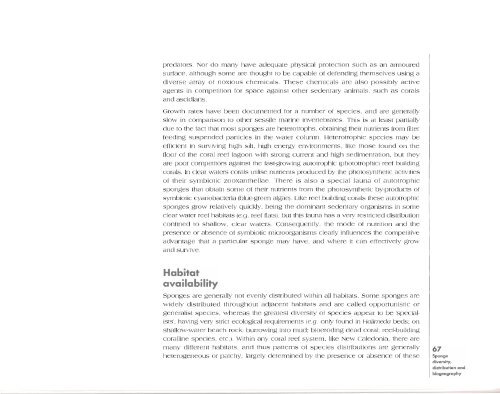Sponges of the New Caledonian lagoon - IRD
Sponges of the New Caledonian lagoon - IRD
Sponges of the New Caledonian lagoon - IRD
Create successful ePaper yourself
Turn your PDF publications into a flip-book with our unique Google optimized e-Paper software.
predators. Nor do many have adequate physical protection such as an armoured<br />
surface, although some are thought to be capable <strong>of</strong> defending <strong>the</strong>mselves using a<br />
diverse array <strong>of</strong> noxious chemicals. These chemicals are also possibly active<br />
agents in competition for space against o<strong>the</strong>r sedentary animals, such as corals<br />
and ascidians.<br />
Growth rates have been documented for a number <strong>of</strong> species, and are generally<br />
slow in comparison to o<strong>the</strong>r sessile marine invertebrates. This is at least partially<br />
due to <strong>the</strong> fact that most sponges are heterotrophs, obtaining <strong>the</strong>ir nutrients from filter<br />
feeding suspended particles in <strong>the</strong> water column. Heterotrophic species may be<br />
efficient in surviving high silt, high energy environments, like those found on <strong>the</strong><br />
floor <strong>of</strong> <strong>the</strong> coral reef <strong>lagoon</strong> with strong current and high sedimentation, but <strong>the</strong>y<br />
are poor competitors against <strong>the</strong> fast-growing autotrophic (phototrophiC) reef building<br />
corals. In clear waters corals utilise nutrients produced by <strong>the</strong> photosyn<strong>the</strong>tic activities<br />
<strong>of</strong> <strong>the</strong>ir symbiotic zooxan<strong>the</strong>llae. There is also a special fauna <strong>of</strong> autotrophic<br />
sponges that obtain some <strong>of</strong> <strong>the</strong>ir nutrients from <strong>the</strong> photosyn<strong>the</strong>tic by-products <strong>of</strong><br />
symbiotic cyanobacteria (blue-green algae). Like reef building corals <strong>the</strong>se autotrophic<br />
sponges grow relatively quiCkly, being <strong>the</strong> dominant sedentary organisms in some<br />
clear water reef habitats (e.g. reef flats), but this fauna has a very restricted distribution<br />
confined to shallow, clear waters. Consequently, <strong>the</strong> mode <strong>of</strong> nutrition and <strong>the</strong><br />
presence or absence <strong>of</strong> symbiotic microorganisms clearly influences <strong>the</strong> competitive<br />
advantage that a particular sponge may have, and where it can effectively grow<br />
and survive.<br />
Habitat<br />
availability<br />
<strong>Sponges</strong> are generally not evenly distributed within all habitats. Some sponges are<br />
Widely distributed throughout adjacent habitats and are called opportunistic or<br />
generalist species, whereas <strong>the</strong> greatest diversity <strong>of</strong> species appear to be 'specialists',<br />
having very strict ecological requirements (e.g. only found in HaJimeda beds; on<br />
shallow-water beach rock; burrOWing into mud; bioeroding dead coral; reef-bUilding<br />
coralline species, etc.). Within any coral reef system, like <strong>New</strong> Caledonia, <strong>the</strong>re are<br />
many different habitats, and thus patterns <strong>of</strong> species distributions are generally<br />
heterogeneous or patchy, largely determined by <strong>the</strong> presence or absence <strong>of</strong> <strong>the</strong>se<br />
67<br />
Sponge<br />
diversity,<br />
distribution ond<br />
biogeography

















